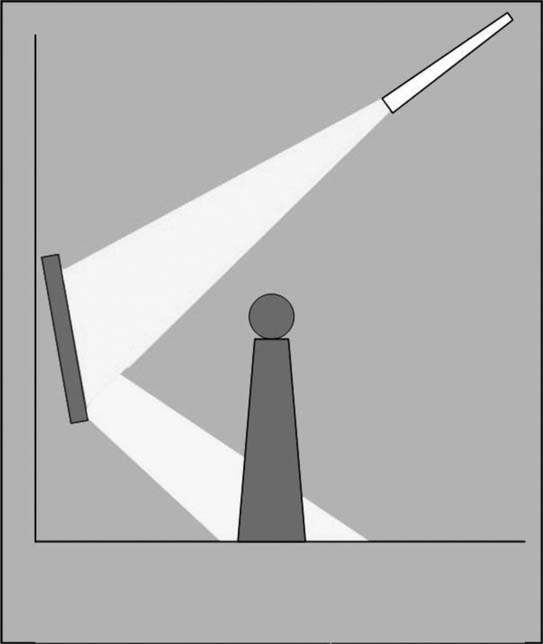
Topics in Photographic Preservation 2007, Volume 12, Article 8 (pp. 37-46)
Presentation History:
This paper combines two joint presentations by the authors at two Photograph Materials Group (PMG) meetings: the PMG session of the 2006 AIC Annual Meeting in Providence, Rhode Island and the 2007 Joint PMG/ICOM-CC WGPM Meeting in Rochester, New York.
The daguerreotype exhibition “Young America” (2005–2006) was a comprehensive retrospective of the works of the Boston firm of Albert Sands Southworth & Josiah Johnson Hawes. It drew significantly upon George Eastman House collections, as well as institutions and private lenders from across the country. From the outset, this major daguerreotype exhibition strove to raise the bar in meeting the considerable exhibition and conservation challenges inherent in exhibiting the daguerreian medium. “Young America” introduced innovations in lighting and display of daguerreotypes, incorporated a secondary preservation housing system to maintain a sealed micro-climate for the exhibition daguerreotypes, and instituted a high resolution, digital image based condition report and a monitoring program that was completed at each installation and de-installation during the multi-venue exhibit. The merit of this program was demonstrated in detecting a range of condition changes occurring during the exhibition period. These documented exhibition observations are now driving further research investigations into image stability and deterioration mechanisms of daguerreotypes undertaken collaboratively by George Eastman House, The Metropolitan Museum of Art, and the Museum of Fine Arts, Boston.
The Boston based partnership of Southworth & Hawes, formed in 1841 and active to 1863, was one of the earliest photographic studios in America. At the time, they were considered one of the nation's most technically innovative and artistically ambitious daguerreian portrait studios and their works have retained that status among scholars today. Southworth & Hawes specialized in celebrity portraiture, and their clientele consisted of numerous leading political, intellectual, and artistic figures of the day. The studio had the regular patronage of Daniel Webster, Henry Wadsworth Longfellow, Ralph Waldo Emerson, Harriet Beecher Stowe, Dorothea Dix, and many other notables of nineteenth century America. Striving for superiority in likeness, beauty, and meaning in their portraiture, Southworth & Hawes created truly iconic images in the first viable photographic medium.
“Young America” was organized by George Eastman House and the International Center of Photography, and exhibited in three venues. The grand opening took place at the International Center of Photography in New York City, in June 2005. In September 2005 the exhibit traveled to George Eastman House in Rochester, New York, and then to the Addison Gallery of American Art in Andover, Massachusetts, where it was on view from January through April 2006.
Approximately 160 daguerreotypes from 13 institutions and 30 private collections were displayed. Over 100 of the exhibition daguerreotypes were in whole plate format (6.5 inches by 8.5 inches), which was the preferred format of Southworth & Hawes, and particularly suited to their artistic and technical mastery of the medium.
The largest contributors to the exhibition were George Eastman House, The Metropolitan Museum of Art, and the Museum of Fine Arts, Boston. These three institutions collectively hold nearly 1,500 of the total of 2,500 daguerreotypes of Southworth & Hawes' studio known to exist. These collections constitute not only the largest repository of work by Southworth & Hawes, but also the largest extant body of work by any single daguerreotype studio in America, or elsewhere.
During the planning phase of “Young America”, conservators, curators, and research scientists from George Eastman House, The Metropolitan Museum of Art, and the Museum of Fine Arts, Boston, collaborated on their concerns for the exhibition conditions for daguerreotypes, and more broadly the field's state of knowledge and agreement on standards of care for daguerreotypes. The group reviewed previous exhibition and documentation records of Southworth & Hawes daguerreotypes containing evidence of an obscuring white haze developing on the plates while on display. Specifically, the 1976 “Spirit of Fact” exhibition of the works of Southworth & Hawes reported of significant condition changes of this nature. Unfortunately there were no object level photo documentation records of this condition phenomenon made at that time. With these issues in mind, the group discussed guidelines for “Young America” with special attention to a condition monitoring program, light levels, and instituting environmental safeguards throughout the exhibition cycle.
“Young America's” design concept was to incorporate recreations of documented Southworth & Hawes historical presentations. A particular idiosyncrasy of the extant body of Southworth & Hawes work is related to their practice of making multiple images at a sitting. The Hawes family kept many of the daguerreotypes that did not go to the clients. For many years these were stored as bare plates in slotted plate boxes until they were sold or donated over the past 75 years. Therefore, most of these daguerreotypes had been placed in modern housings.
Research into Southworth & Hawes company records held in George Eastman House library provided descriptions of the frames they used. As a result, several original frames were identified and they served as models for reproductions of the rosewood ogee and black lacquer frames with decorative brass mats.
Creating a successful viewing experience has consistently been the greatest challenge of daguerreotype exhibitions from both the designer's and conservator's viewpoint. It is extraordinarily difficult to control the lighting sources and eliminate secondary reflections that interfere with optimal viewing of the highly polished silver plate. Light reflected off the plate and cover glass can easily obscure the image, or show it in the negative mode. The challenge is to enhance the positive image, minimize the polishing marks arising from the plate's fabrication -and still maintain light levels within exhibition limits. Non-focused, broad illumination creates undesirable spillover light, and uncontrolled light sources produce disturbing reflections. Many factors affect the viewer's ability to experience the full potential of the daguerreian image.
“Young America” introduced a new solution to lighting daguerreotypes for exhibition. Each framed, wall mounted daguerreotype was lit with a dedicated focus beam projector lamp with knife-edge shutters that were focused on the daguerreotype and the surrounding mat. This lighting schema eliminated spillover light and produced an optimally lit image surrounded by the brass mat. A mounting plate extended the bottom edge of the frame out from the wall, maintaining the plane of the plate at an 8° angle to the wall. This upward angle eliminated direct reflections and made it nearly impossible to view the daguerreotype in the negative mode. The lighting system was adjusted between 8 and 12 foot-candles by the insertion of metal screens to maintain consistent color temperature and desired light levels. The light was positioned off-axis to center of the plate in order to minimize visibility of the polishing marks, thereby enhancing the plate's dynamic range. Gallery lighting was kept low to minimize extraneous reflections and enhance the power of the daguerreotype image.

Figure 1. Diagram of the lighting design developed at George Eastman House. The 8° angle of the daguerreotype to the wall places the viewer outside the reflective light cone and maximizes the optimum positive view of the daguerreotype. The LSI BP 75 Series focus beam projector lamp allowed for a precise area and shape of illumination.
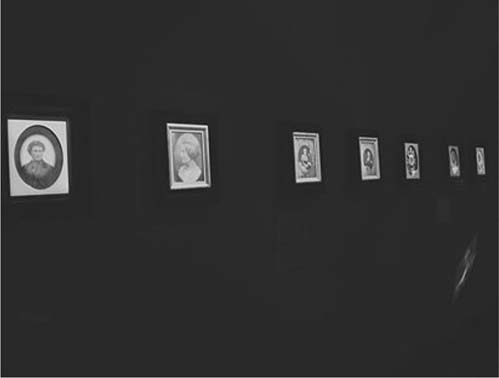
Figure 2. View of framed, wall mounted whole plate daguerreotypes at Addison Gallery. One light fixture is dedicated to each plate.
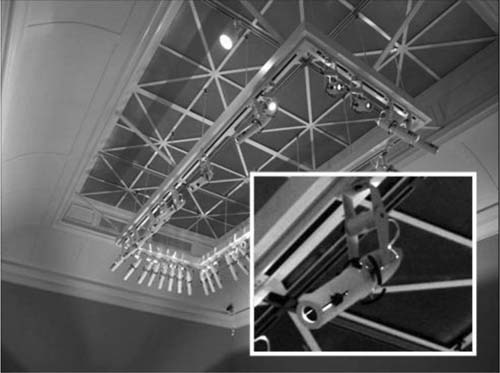
Figure 3. Superstructure holding the projector lamps. Inset of an LSI lamp projector lamp unit.
A secondary sealed enclosure with a controlled micro-environment was developed for this exhibition. It was considered necessary because of the poor environmental protection of the existing housing systems for many of the exhibition plates. These housings generally consisted of a matboard backing board with a matboard spacer separating the cover glass from the daguerreotype plate. The packages were bound with Filmoplast P-90 (Neschen™) or other paper-based tapes, typically in four strips. Research into the protective qualities of this widely used model for daguerreotype packages (Murata, ARP 2003) demonstrated the permeability of binding tapes to atmospheric conditions. Murata's findings were followed up by testing air permeability of the matboard housing package (Wiegandt, ARP 2005), which demonstrated that they achieved a complete air exchange with the surrounding environment within 168 hours.
This research raised concern about the exhibition design using modern reproduction frames made from walnut and rosewood, woods that contain high levels of extractives that emit organic acids. Furthermore, the frames were to be finished with traditional oil stains and coated with natural varnishes and sulfonated paints to match the frames made by Southworth & Hawes. Even though conservators recommend products used in exhibits be inert and non-reactive to the artifact, and an exhibit schedule allowing for complete off-gassing of volatile organic compounds -often other solutions must be found to provide environmental protection to sensitive collection objects. In this case, given the situation, the highest priority was to isolate the potentially chemically reactive daguerreotype image from the immediate frame environment by placing the plate package into a sealed secondary preservation housing. It should be noted that there was no opportunity to replace the existing plate packages, either for the George Eastman House collections, or for the many lenders who provided plates in similar housings. Both time constraints and the absence of a well tested superior design precluded that option.
At present, there is no agreed upon conservation standard or model for daguerreotype housings or binding systems. Questions remain among conservators as to the degree and type of seal that housings should have. Nor is there definitive guiding research on the types of materials that should comprise a binding package. Should packages be sealed from the surrounding environment? What effect might housing materials have on the daguerreotype inside a sealed package? What are the risks when a seal fails and then potentially damaging agents are retained at a higher concentration than if the package allowed air exchanges? Acknowledging the critical need for further research, this paper does not address these broader issues, rather it offers the rationale and method for an exhibition term preservation housing as a beneficial preservation measure for the reasons mentioned. The testing protocols and methods presented here are offered as an approach toward new research on the open questions regarding the housing and preservation environment for daguerreotypes.
Design parameters for the secondary protective housing called for efficient and complete assembly and disassembly, without causing damage to the existing housing packages. It was to be a sealed protective enclosure capable of retaining a low moisture (<30% RH) microclimate for the term of the exhibit.
The secondary housing was comprised of a 20 gauge copper tray sized to contain the glazed matboard plate package. The purpose of the copper was to provide an environmental barrier, physical protection, and serve as an oxygen/contaminant scavenger. The tray had raised edges so it fully contained the matboard package. The corner joints were soldered. The copper was abraded to provide a greater reactive surface area, detergent and ultrasonically cleaned, solvent degreased, and dried. Metal foil tape (3M™ 427) with pressure sensitive acrylic adhesive was used to bind the tray to the glazing and effect a seal. The 3M™ 427 tape was tested and passed the Photographic Activity Test (P.A.T.)™ conducted at Image Permanence Institute., Rochester Institute of Technology.
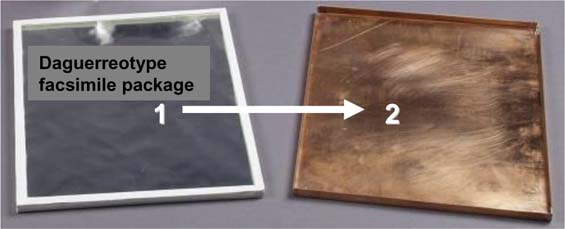
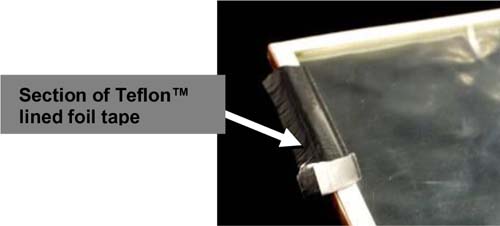
Figures 4 and 5. Steps illustrating the preparation of the secondary preservation housing
The copper tray was fabricated by a local sheet metal company. In assembling the package, a strip of Teflon™ tape was placed in the center of the foil tape to prevent the adhesive from contacting the Filmoplast binding of the matboard package. Several millimeters of the foil tape adhesive was in contact with the glass and the copper tray, making a complete seal. The copper tray served as a reservoir of highly oxidizable metal inside the sealed package. In theory, the readily available copper, freshly abraded as a highly reactive surface positioned outside the primary daguerreotype package, would respond preferentially to potentially reactive contaminants that might otherwise affect the silver surface. Additionally the tray served as physical protection and a non-diffusing barrier to the exterior environment.
The preservation package incorporated two sheets of 4-ply desiccated, unbuffered matboard to maintain the interior environment below glass deterioration potential of 42% RH, and to prevent corrosion potential. The average RH inside the package was equilibrated at approximately 25% RH.
A facsimile package was tested in a reaction vessel containing saturated NaCl (relative humidity [RH], 75%) for three months. The pressure inside the vessel was varied to test the response of the package to simulated barometric pressure changes; the induced fluctuations were well beyond the range of actual variations in weather patterns. There was no change in the interior package RH over the test period.
A critical element of the “Young America” exhibition was the development of a detailed condition reporting and monitoring program. This imperative was driven by the previous exhibition history and concern for potential sensitivity of Southworth & Hawes daguerreotypes -coupled with the lack of a consistent method to document condition changes of daguerreotypes. The examination methods were not revolutionary. Their success was based on a rigorous viewing system, allowing for greater accuracy in detecting condition changes than had been achieved in any daguerreotype exhibitions before.
The monitoring program was built on quality-controlled high resolution digital images of the daguerreotypes. The imaging quality was driven by the reproduction requirements of the catalogue raisonnée produced for the exhibition: “Young America. The Daguerreotypes of Southworth & Hawes”. Museum Photographics, Inc. in Rochester, NY, was contracted to photograph the daguerreotypes to these specifications. A Canon EOS D-1 Mark II camera provided 4992 × 3328 megapixels image resolution producing ~20 MB RAW files that were saved also as TIFF format.
A two-step method was ultimately applied for the examination and monitoring program. First, a Microsoft™ Word document with general descriptive and condition related information about the object was created. Subsequently, the high resolution digital image file was opened in Adobe Photoshop to serve as the platform for a thorough and refined condition report. A color coded key was generated and used with the drawing and marking tools in the software to indicate the deteriorated areas of the daguerreotype.
A portable lighting and viewing set-up was used to compare the daguerreotypes to the electronic reference images. Photoshop allowed for temporary manipulation of contrast and brightness for better comparison. For consistency, the same light sources that had been used for capturing the digital images were used for all the visual examination and monitoring of the daguerreotypes. The daguerreotypes and their condition were monitored before and after each of the three venues, and the cumulative observations were merged into the records. For further consistency, the same individuals did all the monitoring. The authors believe this factor was important in detecting minute changes in condition.
To safeguard the electronic files, they were stored in several places, on two portable computer hard drives, two external hard drives, and the secure network data pool serving George Eastman House collections. A paper copy of the condition reports complemented the digital data and served as an additional back up.
During the ten month, three venue exhibition, condition changes were conclusively detected on some daguerreotypes. Most notable and alarming was the development of a disfiguring bloom or white haze that occurred within one month from the exhibit opening.
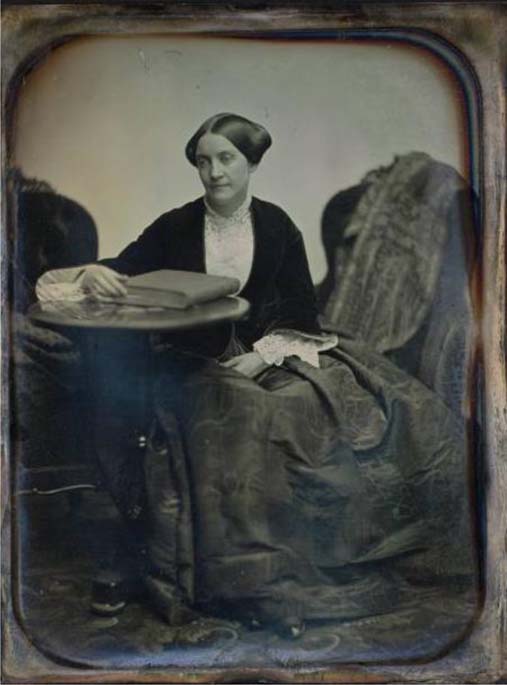
Figure 6. Daguerreotype before exhibition. [Unidentified Woman, ca.1850. Whole plate daguerreotype. George Eastman House. 1974:0193:0034]
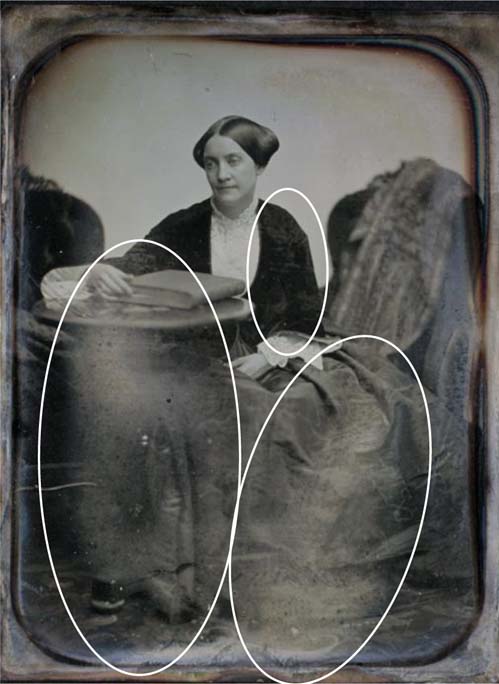
Figure 7. Daguerreotype after one month in exhibition; areas of white haze noted.
One plate, [Henry I. Bowditch], developed distinct halos around pre-existing corrosion spots and expansion of other corrosion features (Figures 8–12). These changes were detected after the last venue.
No correlation was observed between the location of these white deposits and the image features, such as highlights or dark areas. Similar descriptions of image deterioration had been noted in earlier exhibition records of Southworth & Hawes daguerreotypes. These observations and condition records raised the imperative for further analytical research into the forms and causes of daguerreotype deterioration. Following the “Young America” exhibition, both George Eastman House and The Metropolitan Museum of Art have been instrumental in documenting and analyzing the daguerreotypes of concern, and researching the potential effects of exhibition conditions.
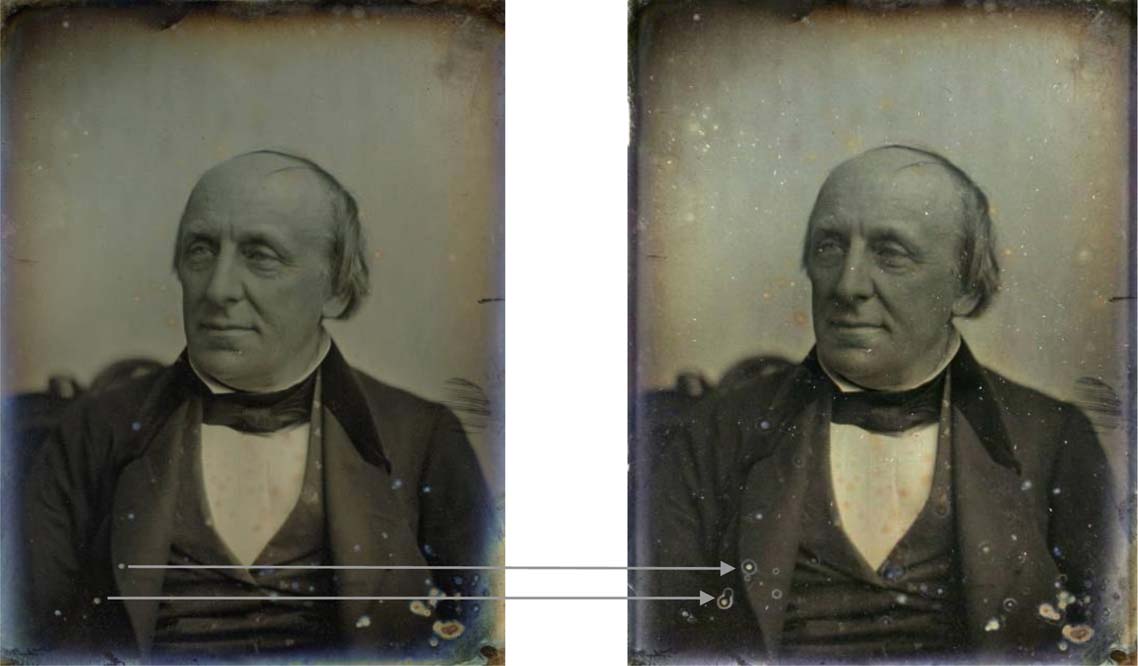
Figures 8 and 9. Development of spots and halos occurring over the course of the exhibit [Henry I. Bowdich, ca. 1850. Whole plate daguerreotype. George Eastman House. 1974:0193:0043]
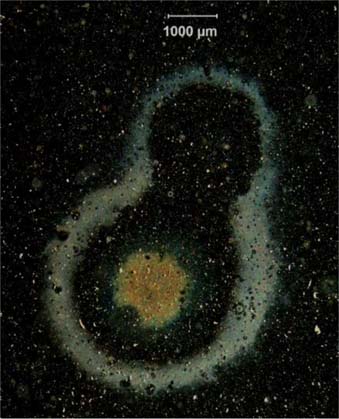
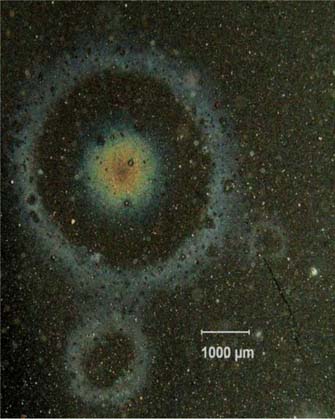
Figures 10 and 11. Details of figure 9. The halos developed around pre-existing nuclei.
Raman spectroscopy has been a most promising technique for analyzing the forms of deterioration observed during the exhibition. The Metropolitan Museum, in collaboration with Silvia Centeno, Associate Research Scientist from the Department of Scientific Research, has been leading this investigation. Results have consistently shown a strong Raman band at ˜240−1cm when analyzing areas of white haze on the exhibition daguerreotypes, and on plates with similar characteristic deterioration. This Raman fingerprint is characteristic of silver chloride. Scanning electron microscopy with energy dispersive spectrometry (SEM-EDS) has confirmed the Raman analyses.
The presence of silver chloride has profound implications for the technical understanding of the daguerreotype, and for its preservation. Silver chloride is light sensitive in the ultraviolet and blue region of the spectrum, which is the basis for all silver halide photographic processes -including daguerreotypy. Upon exposure to wavelengths of light in this spectral region, silver chloride is reduced to metallic silver and re-deposited on the surface of the daguerreotype: AgCl + hv [UV-Vis]→ Ag metal (photo-reduction reaction). Thus, light may indeed have induced the deterioration observed during the exhibition. Much more research is needed to fully understand this phenomenon. Controlled experiments with known concentrations of silver chloride, wavelength and energy specific measurement of light energy coupled with instruments to quantify the levels of silver deposition are proposed for future investigations. Research is progressing to determine the source of the chlorine and the mechanisms of silver chloride bond formation on the daguerreotype surface. Several hypotheses are under consideration as likely sources of chlorine: chemical residues from original processing, cleaning treatments, and atmospheric contamination. The majority of the Southworth & Hawes daguerreotypes, now in institutional collections, were stored for many years as bare plates in wooden boxes, and exposed to the sooty industrial, marine atmosphere of Boston. Exploring these hypotheses may reveal the most logical sodium chloride source. Nonetheless, when sodium chloride is present on a daguerreotype, citations in scientific literature suggest a pathway for the formation of silver chloride: Ag + NaCl matrix + [hv (330–390λ)] → AgCl (Samah et al., Optical responses of alkali-halide matrix (NaCl)- doped silver, Physica E 23 (2004) 217–220, Elsevier Publication).
This potential interpretation raises further concern for potential light sensitivity of daguerreotypes, especially if there is surface contamination from sodium chloride. If that is the case, near UV wavelengths can first induce the formation of silver chloride, and then broader spectrum light exposure can create the potential for silver metal to form through the photo-reduction mechanism. The observations, analyses, and hypotheses may explain the silver chloride and silver re-deposition that is manifested as the image obscuring haze that occurred during the Young America exhibition.
These findings are driving the current research initiative for institutions holding Southworth & Hawes daguerreotypes, but will ultimately be extended to the whole of the daguerreian medium.
The experience of the “Young America” exhibit has generated a new imperative for research on all aspects of technical scholarship of the daguerreotype. The collaborative efforts of the major holders of the Southworth & Hawes legacy, George Eastman House, the Metropolitan Museum of Art, and the Museum of Fine Arts, Boston, are proceeding with plans to conduct a pilot documentation survey using the examination methods described here, and then proceed to conducting a detailed condition survey that will include photomicroscopy and a descriptive thesaurus for deterioration conditions. This methodological approach of capturing essential visual and descriptive data on the daguerreotype executed by conservators trained in examination techniques, will provide the foundation for more extensive research programs. The documentation is intended to provide an open resource for all, and will use web-based systems for greater collaborative research around the world.
There is a finite number of daguerreotypes from this first era of photography, and very few great works by the masters. Daguerreotypes are truly a technical miracle, a magnificent high resolution image formed on an ultrafine surface of silver at the nanometer to micron scale. From the beginning, the vulnerabilities of the daguerreotype have been well documented. Today's imaging tools and analytical instruments provide incontrovertible evidence of the condition changes that are occurring well before they are visible to the eye. It is essential that the conservation community charged with the preservation of this precious legacy develop a new generation of technical expertise that incorporates examination and documentation, non-destructive analysis, predictable treatment protocols, and standards for monitoring condition, exhibition, and storage/housing environments. “Young America” has been a benchmark in daguerreotype preservation, and the issues it has raised now need to be addressed by all conservators who have responsibilities for daguerreotypes.
The authors would like to acknowledge the following organizations and individuals for their support:
The Andrew W. Mellon Foundation
George Eastman House International Museum of Photography & Film and the Advanced Residency Program in Photograph Conservation
The Metropolitan Museum of Art: The Sherman Fairchild Center for Photograph Conservation and the Department of Scientific Research
Museum of Fine Arts, Boston
Grant Romer
Nora Kennedy
Silvia Centeno
Ralph Wiegandt
Assistant Director for Conservation Education
Advanced Residency Program in Photograph Conservation
George Eastman House International Museum of Photography & Film
Rochester, NY
Taina Meller
Associate Conservator
Advanced Residency Program in Photograph Conservation
George Eastman House International Museum of Photography & Film
Rochester, NY
Papers presented in Topics in Photographic Preservation, Volume Twelve have not undergone a formal process of peer review.